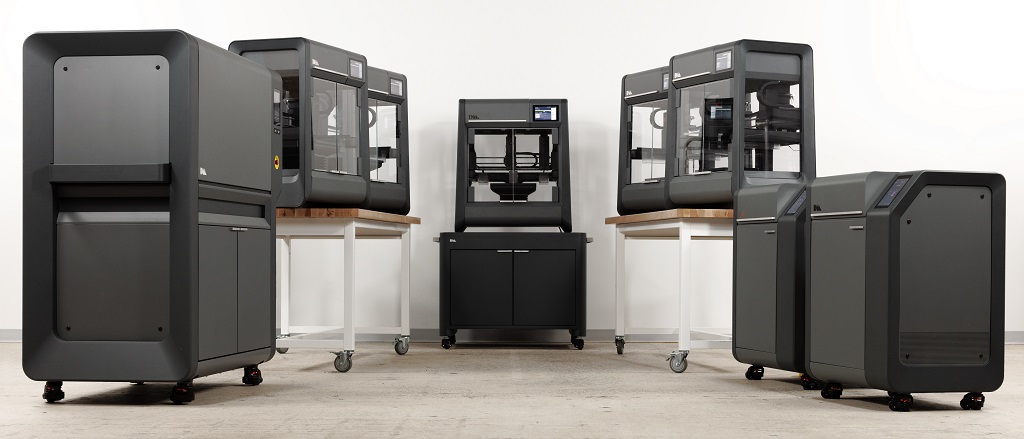![Desktop Metal Studio Fleet [Image: Desktop Metal]](https://fabbaloo.com/wp-content/uploads/2020/05/DMStudioFleet_img_5eb0a7f58c8fb.jpg)
Boston unicorn Desktop Metal is broadening its reach in accessible metal 3D printing with two announcements today.
Set to debut at next week’s IMTS, Desktop Metal is launching its new Studio System+ and Studio Fleet, both set to address in-house metal 3D printing. Both build upon the original Studio System with additional functionalities, capabilities — and scale.
“We are excited to announce Studio System + and Studio Fleet, two office-friendly technologies that will change the game for high resolution metal 3D printing and low volume production. For the first time, on-demand metal 3D printing will deliver accessible and scalable manufacturing that is flexible enough to adapt to diverse business needs, part requirements, production volumes and even cost constraints,” Desktop Metal CEO and Co-Founder Ric Fulop tells Fabbaloo of the introductions.
The Studio System+ is designed as a replacement for the original system, which was introduced last year and is currently shipping. The original remains available for reservation for another month, through October 5th, and the Studio System+ is available now to reserve. Customers who have ordered the original Studio System “will be offered the opportunity to purchase the new Studio System+ features on request with a special discount.”
The price point of Desktop Metal’s desktop metal system(s) remains a key differentiator on the market. The upgraded system is priced at $60,000 for the printer and $160,000 for the full system hardware (printer/debinder/furnace), compared to $120,000 for the original Studio System’s full system hardware ($150,000 including installation and materials starter kit).
![Studio System+ [Image: Desktop Metal]](https://fabbaloo.com/wp-content/uploads/2020/05/StudioSystem2B_img_5eb0a7f60acd9.jpg)
The Studio System+ offers higher resolution, down to the size of a grain of table salt, says Desktop Metal, and includes an in-chamber camera for a real-time look at print progress. According to the company’s press release, new capabilities include:
- Print at higher resolution.
- A new swappable high resolution printhead with supporting software profiles allows for smaller parts with finer features and an improved surface finish. This creates opportunities for new geometries and applications with the ability to print parts similar to those produced with metal injection molding (MIM)—parts featuring sintered voxels as tiny as 240 microns in XY by 45 microns in Z, which is smaller than a grain of table salt—making it ideal for a variety of applications such as parts for consumer electronics, medical devices and automotive.
- Watch a live stream of the build.
- An in-chamber build plate camera captures a live stream video of the part as it prints, so users can closely monitor print progress.
- Experience new software improvements.
- Including automatic mold lock prevention, part positioning and fleet management.
- Debind and sinter in bulk.
- New stackable shelving increases part capacity of the debinder and furnace for even greater throughput. Increased workload volume addresses bottlenecks typical of other solutions at the debind and sinter stages.
- Produce even better parts.
- A new retort box design increases thermal uniformity, resulting in higher-quality parts.
- Reduce operational costs.
- The system now features the option to connect to external gas tanks or a house gas line, which reduces the cost of consumables and results in lower cost-per-part.
Scaling up the possibilities of the Studio System+ is the Studio Fleet. Because why have one 3D printing system when you can have a fleet? Be the admiral of your own metal 3D printing workshop for low-volume production.
The Studio Fleet setup is a scalable solution able to meet the configuration needs of each installation. Users can initially opt for either three or five 3D printers; the company explains:
-
3:1:1 — With 3 printers + 1 debinder + 1 furnace, customers can realize a 200 percent increase in throughput for only a 50 percent increase in system cost.
-
5:2:1 — With 5 printers + 2 debinders + 1 furnace,users will be able to realize 400 percent increase in throughput for only a 100 percent increase in system cost.
Full pricing detail is available on request via the company website.
“Since the introduction of our original Studio System, we’ve worked closely with hundreds of customers across major industries—aerospace, automotive, consumer electronics, cosmetics, and more—to identify key applications and their requirements to incorporate metal additive manufacturing into the design process,” said Fulop. “This research continues to inform our product development, and we are excited to release an enhanced version of the world’s first office-friendly metal 3D printing solution that will help customers more effectively meet those needs.”
![Studio System+ high-resolution 3D printing [Image: Desktop Metal]](https://fabbaloo.com/wp-content/uploads/2020/05/studiosystem2B_newfeature_highresolutionprinthead_img_5eb0a7f67565e.jpg)
Metal prototyping and low-volume production are in focus with these enhancements to the Studio side of Desktop Metal’s portfolio. In-office 3D printing offers convenience factors for on-demand fabrication, as well as close attention paid in development to the safety of those working in these environments. Safely producing parts in an office or workshop space opens new doors — and stands as a proof point for the promise of additive manufacturing.
While incremental improvements to first-generation systems aren’t always the most exciting pieces of news, Desktop Metal’s is one booth I’ll be sure to stop by at next week’s IMTS in Chicago. The show this year is set to have a major focus on industrial and particularly metal 3D printing. If previous Desktop Metal tradeshow appearances are any gauge, their booth will surely be a hive of activity as the manufacturing-minded gather to see the latest from the busy company.
Via Desktop Metal











Aerosint and Aconity have proven out their work in multi-metal powder deposition 3D printing.